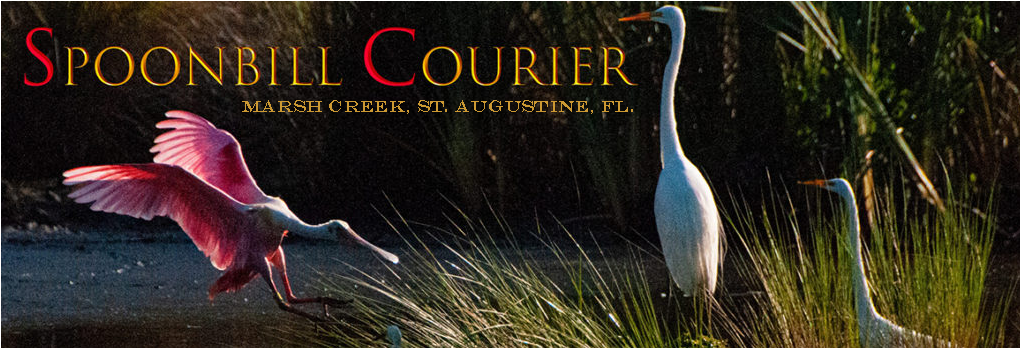By Stan Hill
Holy cow, there is a lot of wildlife we share our homes with here at Marsh Creek Country Club!
I think it would be nice to make some introductions and I think the first introduction is an obvious choice, the Roseate Spoonbill. That is the pink wading bird we see in the ponds and marshes throughout our community.
It is a great bird to have our social clubs and the Courier named after. Like the people here in MCCC, it is a fine looking bird, and is very social, seen usually in flocks. A group or spoonbills is known as a “bowl: … similar to a “gaggle” of geese, or “flamboyance” of flamingos, or “murder” of crows.
While there are 5 species of Spoonbills in the world, the Roseate is the only one native to the Americas and the only one that is not white.






The Roseate Spoonbill is a pale pink wading bird with brighter pink shoulders, a white neck and develops a bald head after the age of 3 years. It is difficult to tell male from female. The males have a thin pink band at the tip of the otherwise grey bill, are slightly larger and tend to be pinker than the females.
The Roseate Spoonbill is a resident breeder in N. America and was on the verge of extinction in the late 1800’s due to plume hunting. Yes, feathers of some birds (egrets & spoonbills) were popular in fashion and resulted in huge population losses. With conservation and climate change the population has slowly been increasing (estimated to be about 11,000 in North America) and their range has been expanding with a sighting in Wisconsin in July of this year (1st time in nearly 200 years).
Rosies (as some people call them) stand approximately 30 inches tall, have a wing span of approximately 50 inches and weigh in at 3 to 4 pounds. They get their color the same way the American flamingos get their color, from their diet. They swing their unique spoon shaped bills back and forth in shallow waters, filtering soft mud to get crustaceans, insects, plant material, mollusks, frogs and small fish.
The birds usually nest in trees and shrubs and will lay an egg a day for a total of 3 to 5 eggs. A trip to the Alligator Farm during breeding season will bring these and many other shore birds up close and personal. Average life expectancy is 15 years in captivity and in the wild 10 years. They reach sexual maturity at about 3 years, about the same time they start losing their head feathers and become bald.
We hope you found this informative and hope to present more topics in the future with an emphasis on birds and are open to suggestions. A fantastic free app to help with bird identification and information is Merlin Bird ID from the Cornell Lab.
References: include Wikipedia, Smithsonian’s National Zoo and Conservation Biology Institute, Audubon, Personal communication with experts at Alligator Farm.





Thanks, Stan! Fabulous photos and it was fun learning more about our beautiful ‘neighbors.’ Keep it up, please!
Stan – your pictures are wonderful and thank you for your research and the very informative write-up. I’ll always remember to call them a bowl of Spoonbills and that they go bald after 3 years! Thanks again
Wow! Wonderful information and outstanding photos, Stan! Thanks so much!
Loved learning about the Spoonbill! We are so blessed to have so many of these beautiful birds in MCCC and great to understand them better. Thank you.